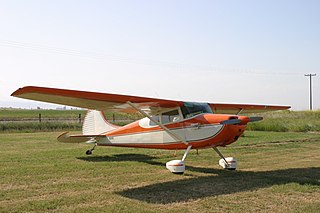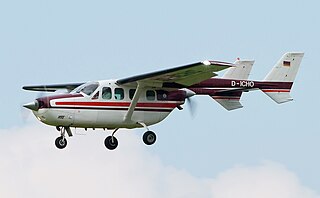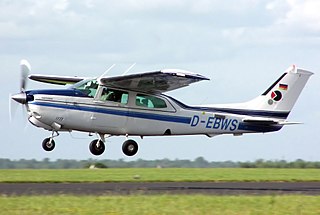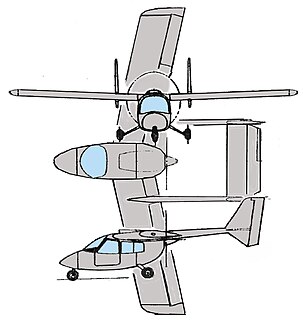
A monoplane is a fixed-wing aircraft configuration with a single main wing plane, in contrast to a biplane or other multiplane, which have multiple planes.

The Cessna T-37 Tweet is a small, economical twin-engined jet trainer type which flew for decades as a primary trainer for the United States Air Force (USAF) and in the air forces of several other nations. The T-37C was also capable of light attack. The A-37 Dragonfly variant served in the light attack role during the Vietnam War and continues to serve in the air forces of several South American nations.

The Cessna 170 is an American light, single-engined, general aviation aircraft produced by the Cessna Aircraft Company between 1948 and 1956.

The Heinkel He 177 Greif (Griffin) was a long-range heavy bomber flown by the Luftwaffe during World War II. The introduction of the He 177 to combat operations was significantly delayed, by both problems with the development of its engines, and frequent changes to its intended role. Nevertheless, it was the only long-range, heavy bomber to become operational with the Luftwaffe during the war. The He 177 had a payload/range capability similar to that of four-engined heavy bombers used by the Allies in the European theatre.

The Junkers Ju 287 was an aerodynamic testbed built in Nazi Germany to develop the technology required for a multi-engine jet bomber. It was powered by four Junkers Jumo 004 engines, featured an unusual and novel forward-swept wing, and apart from the wing was assembled largely from components scavenged from other aircraft. It was one of the very few jet propelled aircraft ever built with fixed landing gear.

The Cessna 120,140, and 140A, are single-engine, two-seat, conventional landing gear (tailwheel), light general aviation aircraft that were first produced in 1946, immediately following the end of World War II. Production ended in 1951, and was succeeded in 1959 by the Cessna 150, a similar two-seat trainer which introduced tricycle gear. Combined production of the 120, 140, and 140A was 7,664 units in five years.

A triplane is a fixed-wing aircraft equipped with three vertically stacked wing planes. Tailplanes and canard foreplanes are not normally included in this count, although they occasionally are.

The Cessna Skymaster is an American twin-engine civil utility aircraft built in a push-pull configuration. Its engines are mounted in the nose and rear of its pod-style fuselage. Twin booms extend aft of the wings to the vertical stabilizers, with the rear engine between them. The horizontal stabilizer is aft of the pusher propeller, mounted between and connecting the two booms. The combined tractor and pusher engines produce centerline thrust and a unique sound. The Cessna O-2 Skymaster is a military version of the Cessna 337 Super Skymaster.

A stabilator, more frequently all-moving tail or all-flying tail, is a fully movable aircraft stabilizer. It serves the usual functions of longitudinal stability, control and stick force requirements otherwise performed by the separate parts of a conventional horizontal stabilizer and elevator. Apart from a higher efficiency at high Mach number, it is a useful device for changing the aircraft balance within wide limits, and for mastering the stick forces.

The Grumman XF10F Jaguar was a prototype swing-wing fighter aircraft offered to the United States Navy in the early 1950s. Although it never entered service, its research pointed the way toward the later General Dynamics F-111 and Grumman's own F-14 Tomcat.

The Curtiss-Wright AT-9 Jeep was a twin-engined advanced trainer aircraft used by the United States during World War II to bridge the gap between single-engined trainers and twin-engined combat aircraft. The AT-9 had a low-wing cantilever monoplane configuration, retractable landing gear and was powered by two Lycoming R-680-9 radial engines.

The Cessna 177 Cardinal is a light single-engine, high-wing general aviation aircraft produced by Cessna. It was intended to replace the Cessna 172 Skyhawk. First announced in 1967, it was produced from 1968 to 1978.

The Cessna 210 Centurion is a six-seat, high-performance, retractable-gear, single-engine, high-wing general aviation aircraft. First flown in January 1957, it was produced by Cessna until 1986.

The Cessna Next Generation Propeller Aircraft (NGP) was a proof-of-concept design for a future family of single engine, fixed-gear, high cantilever wing, light aircraft intended for personal, flight training and commercial use.

The Cessna Airmaster, is a family of single-engined aircraft manufactured by the Cessna Aircraft Company. The Airmaster played an important role in the revitalization of Cessna in the 1930s after the crash of the aviation industry during the Great Depression.

The Airspeed AS.39 Fleet Shadower was a British long-range patrol aircraft design that did not go beyond the prototype stage. A similar aircraft, the General Aircraft Fleet Shadower, was also built to the extent of prototypes. While the concept of a fleet shadower had some promise, the resulting designs were soon overtaken by wartime developments in airborne radar.

The Boeing P-29 and XF7B-1 were an attempt to produce a more advanced version of the highly successful P-26. Although slight gains were made in performance, the U.S. Army Air Corps and U.S. Navy did not order the aircraft.
The Cessna 160 was an American single-engine, four-seater, high wing, strut-braced, prototype monoplane designed in 1962 by Cessna.

The Cessna XMC was a prototype technology demonstrator designed to show advanced aerodynamics and materials. The marketing name of XMC stood for "Experimental Magic Carpet" with the single test aircraft designated Cessna 1014 and later 1034 in company documentation.

The AVE Mizar was a roadable aircraft built between 1971 and 1973 by Advanced Vehicle Engineers (AVE) of Van Nuys, Los Angeles, California. The company was started by Henry Smolinski and Harold Blake, both graduates of Northrop Institute of Technology's aeronautical engineering school.


















